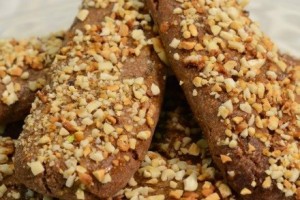As in many cultures, food is an integral part of Maltese culture and tradition. Come Lent, many look forward to traditional foods and embrace this period. Now this may contradict what Lent is about- abstinence and sacrifice- but we wouldn’t be Maltese if we didn’t find a way around this to still enjoy good, hearty, food.
Traditional Maltese food for the Lenten period includes “qagħaq tal-Appostli” (Apostles’ Rings), which are circular loaves of unleavened bread studded with roasted almonds and sprinkled with sesame seeds. I remember many times when I got in so much trouble after being sent down to the town square to buy bread from a little van in the street and by the time I got home, had nibbled at all the roasted almonds- much to my mother’s dismay. These are traditional more towards the end of the lenten period (around Easter week) and many town squares are littered in the evenings with these same little vans selling Apostles’ Rings to the masses after attending church.
Traditional recipes include Ricotta Pie, Qaqoċċ Mimli (stuffed artichokes), Bebbux (snails), Pastizzi tal- Inċova (anchovy cakes) and Qassatat tal- ispinaċi (Spinach cakes). Many of you will recognise these foods from your own cultures, but, every country prepares them in different ways, and if I am honest, when my mother puts down a plate of Qaqoċċ- complimented with a slice of Maltese traditional bread dipped in tomato paste and olive oil- I feel a sense of nostalgia for my childhood.
Although sweets go against the “fasting” specifications, the Maltese have also found a way around this to make sure their sweet tooth is satisfied – road rage and hunger don’t go very well together. J In the days of old, these were sweets “allowed” during this time of year, as they do not contain any sugar, but are made with almonds, honey, milk, flour and spices.
Traditional sweets:
Honey cakes (known as Kwareżimal- from the word quadragesima- meaning 40 days of Lent)
Qassatat tal- ħelu (sweet biscuits)
Karamelli (Carob Julep sweets)

















